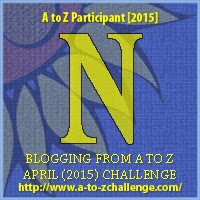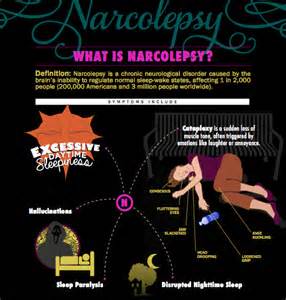I am back on track for the A to Z challenge. I didn’t say I was up to date, just working on it. Now, I am working on ‘N’. I knew exactly what I would be doing for this letter. I have personal experience with this one also. My son, Alex, had Narcolepsy that was misdiagnosed for many years. That is not uncommon. Children are usually not considered to have narcolepsy, that it is more of an adult condition. I believe that is because it is not diagnosed correctly. As the discussion goes on, I will relate back to Alex and his experiences.
What is Narcolepsy? Narcolepsy, also known as hypnolepsy, is a chronic neurological condition that involves the loss of the brain’s ability to regulate the sleep-wake cycles normally. At times throughout the day, the patient may experience irresistible bouts of sleep from a few seconds to several minutes. (1) The sleepiness may be profound and may lead to falling asleep in inappropriate situations. There are four classic symptoms:
1. Excessive Daytime Sleepiness (EDS)
2. Cataplexy: A sudden, transient episode of the muscles going limp. This could involve only the arms or face or the whole body, causing the child to collapse while fully conscious and aware, typically triggered by emotions such as laughing, crying, terror, etc. This affects about 70% of people with narcolepsy.
3. Sleep Paralysis: A child is unable to move or speak for one to two minutes, usually while awakening.
4. Hypnagogic Hallucinations: The child has vivid dream-like auditory (hearing), visual (seeing), or tactile (feeling) sensations that are not there. It may occur while falling asleep or waking up.
In order to diagnose narcolepsy, the doctor must order a sleep study test called a polysmnogram and a multiple sleep latency test, or nap study to show the activities of the brain and body while the child is falling asleep and sleeping. A normal sleep cycle has two major categories: REM (rapid eye movement) and non-REM. The REM sleep is when the muscles are relaxed, child is dreaming, and there is episodes of rapid eye movements, and low amplitude waves on an EEG (encephalograph). Non-REM sleep is divided into four stages from light sleep (stage 1) to stage IV (Delta or deep sleep). This occupies about 75% of normal sleeping time while REM occupies the remaining 25% and usually occurs more toward morning. Sleep disorders disrupt the sleep cycles. (2)
Usually before all the tests are done, a complete physical history is taken with particular interest in the child’s sleep habits, and it is assumed that he/she has sleep apnea: A serious sleep disorder that occurs when a person’s breathing is interrupted during sleep. People with untreated sleep apnea stop breathing repeatedly during their sleep, sometimes hundreds of times. This means the brain — and the rest of the body — may not get enough oxygen, according to WebMD. A delay of ten years from the onset of the symptoms of narcolepsy to the time of diagnosis is common.
In Alex’ case, he had many sleep tests but did not fit into the sleep apnea category so they thought his symptoms were caused be his severe GERD. We bought him a bed that the head would elevate because we tried the blocks under the bed. We tried the wedge under the mattress. He was eight at the time, so we got him a Bill the Builder bed chair. Nothing worked. After spending thousands of dollars on his head elevating bed, we found that it did not work either. You are probably wondering when did he get diagnosed with narcolepsy? Oddly enough, it was ten years after the doctors realized that Alex had a sleeping disorder of some kind. He was eighteen driving home from a date and fell asleep at the wheel and went over a steep embankment off the freeway. The police thought he was drunk or on drugs at first, but then realized that he wasn’t. They were skeptical because he had many scars on his neck and shoulders. The car was totaled. Apparently, no one has ever survived a crash in that area before. That is when they did the full studies and found out that he had narcolepsy with cataplexy, sleep paralysis and hypnagogic hallucinations.
It is said to be rare in children, but I believe that they are being misdiagnosed. At least, Alex was.
References:
1. Ninds.nih.gov. 18 July 2013. Retrieved 3 March 2014.
2. © 2015 The Nemours Foundation/KidsHealth®.
Disclaimer: The resources on this site should not be used as a substitute for professional medical care or advice. Users seeking information should consult with a qualified healthcare professional.





I remember my entire childhood having problems with sleeping, to the point my parents got so tire and frustrated they left my at relatives house in order to take break, after many years of the issue of me waking up at night, as an adult I when and did sleep study and bang, turns out I have sleep apnea.
LikeLiked by 1 person
I am glad you were finally diagnosed!
LikeLiked by 1 person
It really weird, because I get a lot of young doctors who are like “here take this pills and see me in a week” and don’t care for that sort of medical care, I like to be talked to and explain.
You know after years of having condition you sort of learn quite a bit of medical stuff
LikeLiked by 1 person
That is the truth. That is something I am trying to change with my nonprofit. How teens and young adults are treated by healthcare providers.
LikeLiked by 1 person
The problem is that we teach healthcare individuals to stop carrying for a person, but the same time we need that care
LikeLiked by 1 person
Well, that isn’t altogether true. I was a nurse for thirty years and am a Physician Assistant now. I can tell you that the teaching is their, The problem is that Healthcare providers are overloaded with patients, paperwork and very little time. Hopefully with the work that I am doing, this will change.
LikeLike
Again so informative thank you . ❤
LikeLiked by 1 person
You’re welcome. Have a great day. ❤️
LikeLiked by 1 person
So glad your son was ok. That must have been very scary! Thank you for sharing!
LikeLiked by 1 person
You are so kind. My son had many chronic illnesses and he lost his battle when he was thirty years old. He was ready. I wasn’t. ❤️
LikeLike
I am truly so sorry about your loss. I had no idea. I feel like an idiot. I apologize for my lack of awareness. You are so inspiring.
LikeLike
No need to apologize. How were you to know. I didn’t mention it in the post. Thank you for saying that I am inspiring. That made my day! ❤️
LikeLiked by 1 person